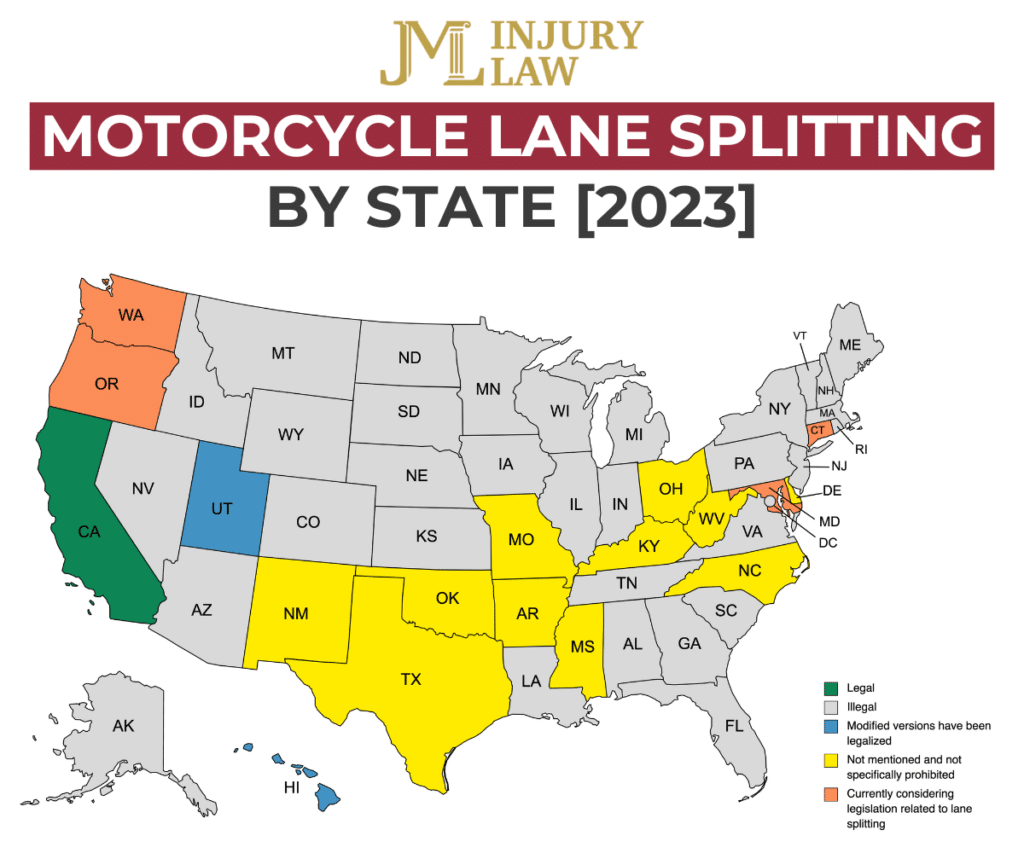Motorcyclists in Texas may soon benefit from the time-saving practice of lane splitting. This technique, which involves maneuvering between lanes or rows of slow-moving or stopped traffic in the same direction, effectively allows riders to bypass congestion and reach their destinations more swiftly. In December 2018, State Senator Kirk Watson proposed a bill to legalize lane splitting throughout Texas, potentially transforming the motorcycling experience for riders across the state. However, as of 2023, lane splitting remains illegal in Texas.
If the bill were to pass, motorcyclists would have the ability to navigate through traffic jams with ease, significantly shortening their travel times. Additionally, this practice could help reduce the likelihood of rear-end collisions involving motorcycles. Yet, due to their smaller size and reduced visibility, lane splitting also poses risks, as motorcycles can be difficult for drivers to see when they switch lanes. Despite ongoing support for the legislation, as of 2023, lane splitting has not yet been legalized in Texas.
Texas Lane Splitting Laws: What You Need To Know
It’s crucial to understand that lane splitting is illegal in Texas. There are no specific laws allowing motorbike riders to navigate between vehicles. According to the Texas Transportation Code § 545.060, all motorists are required to remain within a single lane of traffic at all times. This provision clearly establishes that any form of lane splitting is considered unlawful within the state.
Maintaining a safe and efficient road system is essential, and therefore, all vehicles—motorbikes included—must stay in their designated lanes. If a driver intends to change lanes, they must ensure the path ahead is clear of vehicles and other hazards before proceeding. Lane splitting, however, poses safety concerns due to the proximity of motorcyclists to other moving vehicles. For instance, imagine a small car sandwiched between two larger ones; this scenario increases the risk of a car accident significantly.
Recognizing the potential dangers posed by sudden lane changes, Texas officials have declared lane splitting illegal to protect drivers from preventable risks. Thus, the prohibition of lane splitting throughout Texas serves as a vital measure to safeguard all road users from unnecessary harm.

Penalties for Lane Splitting in Texas
Unfortunately, it’s still common to see motorcycle riders in Texas engaging in lane splitting. During rush hour, many cyclists find it difficult to resist the temptation to bypass the long line of cars and move ahead more quickly. This impulsive behavior is understandable in our fast-paced society, where attention spans are shorter than ever.
However, just because many motorcyclists participate in this practice does not make it acceptable. If you’re caught lane splitting in Texas, be prepared for a substantial fine of $175. Repeated offenses could lead to the revocation of your driver’s license, as driving is a privilege earned through responsible behavior. Accumulating too many infractions can result in the loss of your driving privileges altogether. So, think carefully about the risks associated with violating traffic laws.
What Are the Dangers of Lane Splitting for Motorcyclists?
Lane splitting poses significant hazards that many drivers may not fully recognize, leading to potentially devastating motorcycle accidents. By engaging in lane splitting, motorcyclists expose themselves to various precarious risks, including:
Unpredictability
Motorcyclists must remain vigilant of their surroundings and stick to designated lanes. Lane splitting can diminish visibility, making it challenging for drivers to anticipate their movements, which may result in accidents. If lane splitting is unavoidable, it should be executed with caution, ensuring clear communication of intentions to other road users.
Lane Changes
In Texas, lane splitting can be particularly perilous as drivers may abruptly change lanes without checking blind spots or signaling. Additionally, collisions are more likely to occur when vehicles frequently shift between lanes in slow traffic to access faster-moving lanes. It is crucial for all drivers to exercise caution and maintain heightened awareness when sharing the road.
Space Limitations
Navigating between two lanes of traffic can be more dangerous than it appears, given the restricted space available. This limitation applies to lane splitting as well; motorcyclists may struggle to maintain stability within the confined area, increasing the likelihood of accidents—especially when attempting this maneuver in heavy traffic.
Frequently Asked Questions
Is Lane Filtering Legal in Texas?
Motorcyclists face a staggering risk on the road, being 28 times more likely to suffer fatal accidents compared to drivers of other vehicles, according to the National Highway Traffic Safety Administration (NHTSA). Regardless of whether lane splitting is legal, it is crucial to take proactive steps to protect yourself. Here are some important precautions to consider:
- Wearing a motorcycle helmet can significantly enhance your safety. Helmets have been shown to reduce the risk of injury by an impressive 69% and decrease the likelihood of fatality by 37%.
- Regularly check that your headlamp and brake lights are functioning properly.
- Don reflective clothing when riding after dark or in low visibility conditions to ensure that other drivers can easily see you.
- Always use signals when turning.
- Exercise caution when sharing lanes or changing lanes.
- Invest in high-visibility motorcycle gear, which can lower your chances of being involved in an accident by 37%.
- Make sure to wear appropriate footwear designed for riding.
Understanding the Differences Between Lane Splitting, Lane Filtering, and Lane Sharing
When it comes to lane splitting, filtering, and sharing, it’s essential for all drivers to recognize the key distinctions. In the United States, while some states allow lane filtering, lane splitting remains prohibited—a critical point for anyone on the road. Familiarizing yourself with these differences is vital for safe driving.
- Lane Splitting: This refers to the practice where motorcyclists navigate between vehicles traveling at slower speeds in the same direction.
- Lane Filtering: This technique enhances safety for motorcyclists by allowing them to maneuver between cars in stopped traffic. It significantly reduces the risk of being rear-ended.
- Lane Sharing: Also known as riding side-by-side in the same lane, lane sharing is illegal in Texas, although many other states across the U.S. have legalized this practice.
Where Is Lane Splitting Legal in the U.S.?
In Texas, lane splitting is illegal. However, if you’re seeking a state that permits this practice, California is the only one that allows motorcyclists to split lanes as a means of alleviating traffic congestion. While many riders take advantage of this method, it’s important to note that passing between two passenger vehicles is technically against the law.
Despite the absence of a formal law legalizing lane splitting in Texas, those caught attempting this maneuver can face legal repercussions due to its inherently risky nature. Law enforcement considers such actions highly irresponsible, as they require motorcyclists—who are on inherently vulnerable vehicles—to navigate through larger cars at high speeds. If you decide to try lane splitting, be prepared for potentially serious consequences if you are caught.
Motorcyclists find themselves in a particularly precarious situation; in the event of an accident, they bear the full brunt of the impact, resulting in more severe injuries. In contrast, cars offer passengers some protection from crashes, as their frame and other components absorb part of the force. While a passenger might suffer a fracture in a collision, the consequences can be fatal for riders. Moreover, lane splitting significantly increases the risk of accidents for motorcyclists as well.
Contact Our Texas Personal Injury Law Firm Today
While lane splitting is a common practice among motorcyclists in Texas, it carries a range of risks. If you’re involved in an accident while lane splitting and need to defend your case, the expertise of a Texas personal injury attorney can be invaluable. They can effectively articulate your perspective and, with their experience, increase your chances of receiving partial or full compensation, helping you get back on track with your life.
Choosing the right law firm is crucial for protecting your rights and building a strong case. An attentive legal team will listen closely to your story and provide comprehensive insights into your available legal options. Collaborating with seasoned lawyers significantly boosts your likelihood of success, so don’t hesitate to enlist an expert. If you’ve suffered injuries in an accident, reach out to JML Injury Law today for a free consultation and discover how we can assist you.



